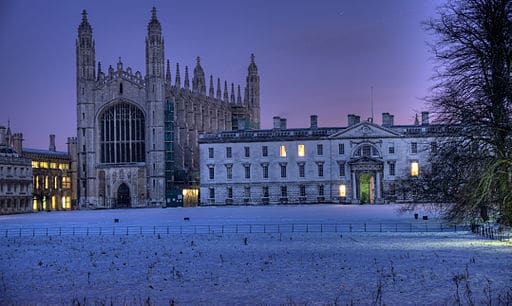
One of the most beloved musical Christmas traditions in the English speaking world is the service known as “the festival of nine lessons and carols.” I first encountered this service on Christmas Eve as a student in England. When I returned to the US and found myself involved in my first year of a new church plant, we quickly incorporated it into our holiday plans, even with rented facilities and meager music resources.
Of course, the tradition of singing carols and reading Scripture in church at Christmas time is very old. But the service of nine lessons and carols dates back to 1878 at the Truro Cathedral in Cornwall, England, on Christmas Eve. The tradition was quickly picked up by other Anglican churches. In 1918, after World War I, it was introduced at King’s College in Cambridge. What many know as the annual King’s College Christmas Eve service was first broadcast by the BBC in 1928. It has been broadcast every year since then and replicated by churches throughout the world.
The idea behind a service of lessons and carols is basic: seven to nine chronological Bible readings focused on the coming of Christ interspersed with the singing of carols sung by a choir or congregation.
Here’s why I love this particular service. First, it is very simple. In fact, it is so simple that a church with hardly any staff resources or music teams can pull it off. You simply let the congregation be the choir. We did this as a new church plant in a rented Veterans of Foreign Wars (VFW) hall for our first candle light Christmas Eve service. But I have since done it in a large church with a beautiful sanctuary and an exceptional music ministry. That’s the great thing about this service. You can do it with few musical resources or abundant resources. Either way, the same simple, dignified structure works.
Second, it is not only easy to put together, it is also designed so that the congregation participates. The temptation of many churches (contemporary or traditional) is to rely on professional musicians with the unfortunate effect that the congregation becomes like an audience at a concert—they become spectators. In contrast, this special service is participatory. It invites the congregation to join in and sing, and in the process, it teaches them some great hymns and carols of Christmas. It also allows families to read the Scripture readings, and in so doing, familiarizes them with the whole Bible.
The music for this service can be sung with all congregational carols, or interspersed with choral/ensemble sung carols as well. Traditionally it begins with Once in Royal David’s City. It can include well-known carols, like Hark the Herald Angels Sing (usually sung at the end of the service), or less familiar ones such as Jesus Christ the Apple Tree. At our church, near the end of the service, we sang Silent Night while lighting our candles and “passing the light.”
Third, I love this service because it helps us see how the Bible holds together. The nine readings are taken from both the Old Testament and the New Testament. They stretch from Genesis to the gospels. They are not haphazard readings. Each passage unfolds the promise of a coming savior. With each text the promise gets brighter. As it is read, the listener begins to realize that the Bible is not a random assortment of passages, but rather a unified story of redemption centered on the person and work of Jesus Christ. The readings usually climax with John 1, reminding us that the Word which created the world became flesh and lived among us. This is the one service in the year when worshippers get to hear the sweep of Scripture. The Christmas story becomes that much more astounding when a congregation hears it in its full Biblical setting.
Fourth, this service provides a striking contrast to the secular worldview that presses in on us all year long. The grand narrative of our culture tells us that there is no God, there is nothing special about earth, there is no creation of male and female, there’s no image of God in man, there are no divine covenants, and no rebellion against heaven. There is no promise of hope given to the earth, there is no savior, no return of a king, and removal of the curse and renewal of creation. The dominant cultural narrative of our day is downright depressing when you put it all together.
In contrast, the Biblical story proclaimed in the service of lessons and carols is a glorious narrative. It tells us that there is a God, he has drawn near to this planet, he created us in his likeness, he has entered into covenants with the people of the earth. When we turned our back on him and committed cosmic treason, he answered our calamity through the redemptive work of his eternal son. He is not only the promised messiah and the Son of God made flesh, he is the lamb of God who takes away the sins of the world. He is the divine warrior who will come again to make things right and will sit on David’s throne reigning forever.
I don’t know about you, but I love this story. I need to constantly let it wash over me and reduce the shaping power of the nihilistic dirge of our age.
Which takes me to my final point. I love this unique service because it helps us focus on the real meaning of the season. It keeps Christ in Christmas.
When we did it as a new church plant, we had children begin the readings, and then the pastor read the final text, John 1, before preaching a short Christmas Eve sermon. We ended by singing Silent Night with candles lit all around that makeshift sanctuary. But what a beautiful night it was!
If you incorporate this service into your Christmas Eve celebrations, let me give you a few suggestions. Before you try it, read about it, look at the way it has been done traditionally. Respect the wisdom of that order of service. But don’t so mimic the way others do it that it becomes stiff. Let this service lead you to worship God and bless your congregation with the gospel.
Also, when you put it together, don’t ignore why Jesus came (to die for sinners) and don’t forget the promise of his return. Let your people know that just as Advent looks forward to Christmas, so Christmas looks forward to the return of the king!
I’ve been blessed by this special Christmas service now for decades. I’ve experienced it in many different settings and it still hasn’t become old. In fact, each year God speaks to me through a different line of a Scripture reading or of a carol, and I become more aware of my need for a savior. Evidently, I am not alone. Perhaps that is why the service of lessons and carols has become such a beloved musical Christmas tradition all over the world.
